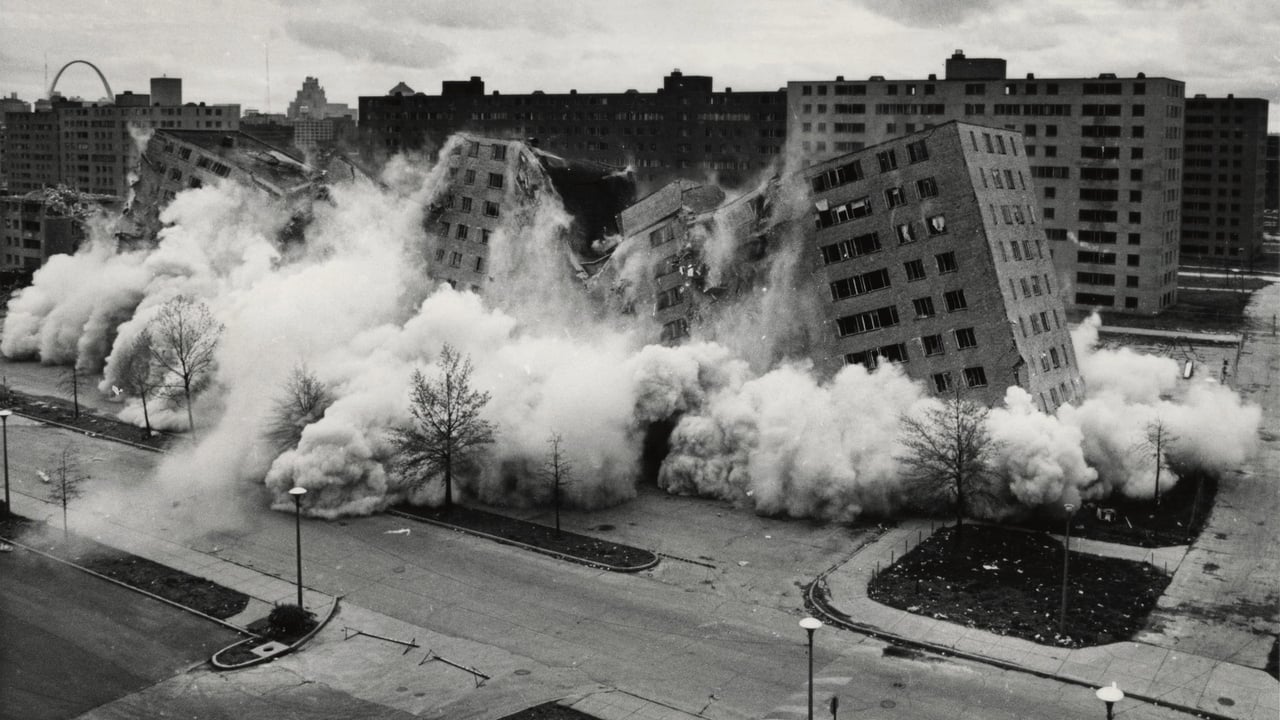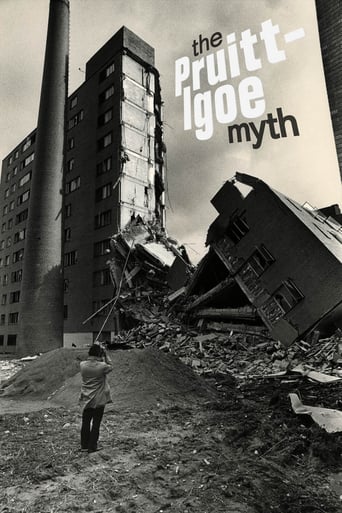

Just so...so bad
... View MoreBrilliant and touching
... View MoreAll that we are seeing on the screen is happening with real people, real action sequences in the background, forcing the eye to watch as if we were there.
... View MoreWhile it doesn't offer any answers, it both thrills and makes you think.
... View MoreThe Pruitt-Igoe housing development in St. Louis is the focus of this film, but it could have just as soon been Cabrini-Green in Chicago or any one of a number of similar projects across the American big cities. It's an exploration as to why these huge public housing projects became hellish instead of the paradises they were originally envisioned. Fortunately, the filmmakers don't pick any one or two simple answers but talk about the multitude of issues that led to the projects failing...and ultimately being demolished. Among the problems discussed in the film were the lack of jobs as businesses and middle classes migrated to the suburbs, the increase of violence and vandalism, lack of maintenance, segregation as well as the insane notion that in order to get public assistance that fathers could not remain in the home! This documentary is depressing and few folks would enjoy watching it. Now I am NOT saying it's bad and it's good for folks to become familiar with the issues that come up in the film. But it's just not the sort of thing most people would choose to watch and is probably more a film that educators might show to sociology or other such classes in order to explain the failures of these programs. Interesting and well made...despite it being such a terrible story.
... View MorePruitt-Igoe was among the largest projects of urban revitalization during its time. It was designed to be a cure for the disease of poverty and slums, in which the city and community alike would thrive. The Pruitt-Igoe myth documentary does an outstanding job of painting a vivid picture for one to visualize, the many hardships the residents faced. It concentrated on the issues that lead to the demise, the suffering and segregation but also the positive effects that it had on many people's lives. Initially the residents were extremely excited to move into the community. They described it as a utopia and safe haven as well as a resort. People that lived in the Pruit-Igoe community claim that there was once a sense of community and that at a certain time period "it was full of electric engaging life". However, the green grass and playgrounds didn't last, and soon later the deterioration of the buildings became significantly of concern. Matters were so terrible that people would actually defecate in the elevator and stairs, and burn neighboring apartments. However, professionals claim that this was their unique cry for help. What was the causation of these failures you may ask yourself? Much blame the architect; others blame the welfare state, while others put to blame the people that resided there. The city of St. Louis was expected to grow exponentially during this time frame that the project was being innovated. However, plans didn't go as expected. The city shrunk by 20%, which lead to homes being vacant causing a cascade effect full of negative impacts for the city to endure. Whites moved to the suburbs, and took the jobs with them; this became an even bigger problem because now not only were there vacant homes and apartments but also no jobs to pay for rent. This is one of the main issues to the demise of Pruitt and Igoe. The main idea was that the maintenance would be funded by rent paid by the tenants. It seems like an ingenious plan, where the buildings were basically going to maintain themselves without the input of state or government funding. Nevertheless, no one expected the city to decline greatly and for jobs to move out of reach. This predicament made it nearly impossible for residents to establish a secure form of employment. Thus no employment meant that rent met would not be met, therefore causing a deficit in resources for the maintenance department. After the buildings resort type facade diminished, tenants that had the means to escape left while persons with little to no resources stayed behind. This created segregation within the community, because as suburbs were being built and desirable areas within the city suffered from gentrification, low income individuals were essentially forced to move into Pruitt and Igoe. Another important aspect that the film focuses on is the terrible violence and crime that the community underwent. It became a safe haven for drug dealers and murderers since the buildings were extremely vacant, criminals could easily handle their unlawful activities while remaining under the radar. Pruit-Igoe became representative of black; poverty, crime, and drug abuse. Community activists actively spoke to city officials in an effort to deal with the wrongdoings that the neighborhood was actively facing daily. However, the police blamed the mayor, while the mayor, blamed the state and Washington. It was a cycle of pointing fingers where the people left to suffer without remorse were the residents. Matters became so terrible that police and firemen stopped showing up to the area. Not only is the city to blame but also the tenants, because they would throw fire bombs at the same people that are supposed to protect them. It's extremely counter intuitive from their part. However as before mentioned this was a way of the tenants of demonstrating that they didn't like the conditions in which they were living. An important point made by the film was the many strict laws that the tenants had to abide by in order to have a roof over their head. If the government was going to support them and give them a few extra dollars, they then had to abide by the cruel rules. Residents were not allowed to own a television, or telephone. They felt segregated and isolated; many claim that it felt like a prison environment. Wouldn't you agree? It almost seems to me in my personal opinion as though the government was attempting to keep blacks dependent on the system, virtually modern day slavery where they control their every action and future as well as their children's future-one vicious cycle it all adds to urban issues that we still face to date. However the most absurd rule of all was the fact that men couldn't live in the projects, what's the rationale behind this concept? Splitting of families, kids growing up without father figures, leaving women vulnerable to criminals is what the foolish regulation caused. There was no morality being presented to these helpless individuals, they were treated inhumane and split of their naturalistic rights. With accordance to the film, many people have very good memories of living in Pruitt and Igoe. The nostalgia of dancing in the halls and playground during Christmas brings nothing but tears of joy to their eyes, and the smell of baked goods coming from their neighbors windows brought the simplest of happiness. And although there were many negative phases that were lived many rather looks at the positive memories. It's extremely difficult to figure the source of the demise to this day, as we still face a huge dilemma with public housing. Nevertheless it's safe to say that everyone was at fault; the architect, government, and residents. Not for the source of the problem, since cities change with regards to population and capital, rather for allowing the predicament to reach such a cruel and inhumane way of living.
... View MoreLike most documentaries that come out today, this asks the wrong questions and places blame in the wrong areas. I could go on forever but choose not to.I don't exactly know what the "myth" is in the documentary. Most of the blame looks like it is trying to be aimed at government, which is mostly wrong. This documentary is also dangerous (like most are) because it chooses only the information it wants to present. And I'm not saying that I know all of the facts, because I don't. But what people never do is look things up for themselves. they just take the information that is given to them on a platter and say , "oh, that's horrible. How can people do that?" etc...The real problems are never solved, and real questions are never asked. How did all of the windows break? Did the government do it? Why were things set on fire? Why did people urinate everywhere? Did the government come in and do that? Did the government come in and throw bottles at the policemen and firemen when they tried to put the fires out? I'm sure things were not like the grand ballroom at the housing complex, but who said it had to be? Tenants got mad when rent went up because people were leaving. Why did they leave? Not a hard question to answer. They should be going around yelling and protesting at each other for the rent going up because tenant's behavior caused people to leave which made rent rise. But lets blame society for poor planning and support.This needs to focus on one of the biggest problems facing society today, which is entitlement. It was bad then and it's only getting worse every day.
... View MoreThe Pruitt-Igoe housing projects are currently remembered as one of the worst disasters in federal housing history. There has been ample debate among academics as to why, ranging from architectural problems to poor planning to demographic shifts in the city of St. Louis. This new documentary mostly looks at the latter two ideas and does not interview architects but rather former residents of the projects. Their stories vary from uplifting to tragic and detail the many problems with Pruitt-Igoe. Mostly the film suggests that the depopulation of the city following the explosion of suburban society in the 1950s is to blame for the project's failure. With fewer people there was less of a need for the massive buildings and with a smaller tax base it was impossible to maintain the expensive structures. What the film does show is that most of the people who lived there were decent folks hoping to make a new life, and that it was mostly the outside world that undermined the projects. The director uses several excellent shots including the image of the collapsing towers (they were demolished in the 1970s). Overall he does a superb job of telling a very intriguing and moving story while stimulating a debate on the future of federal housing.
... View More